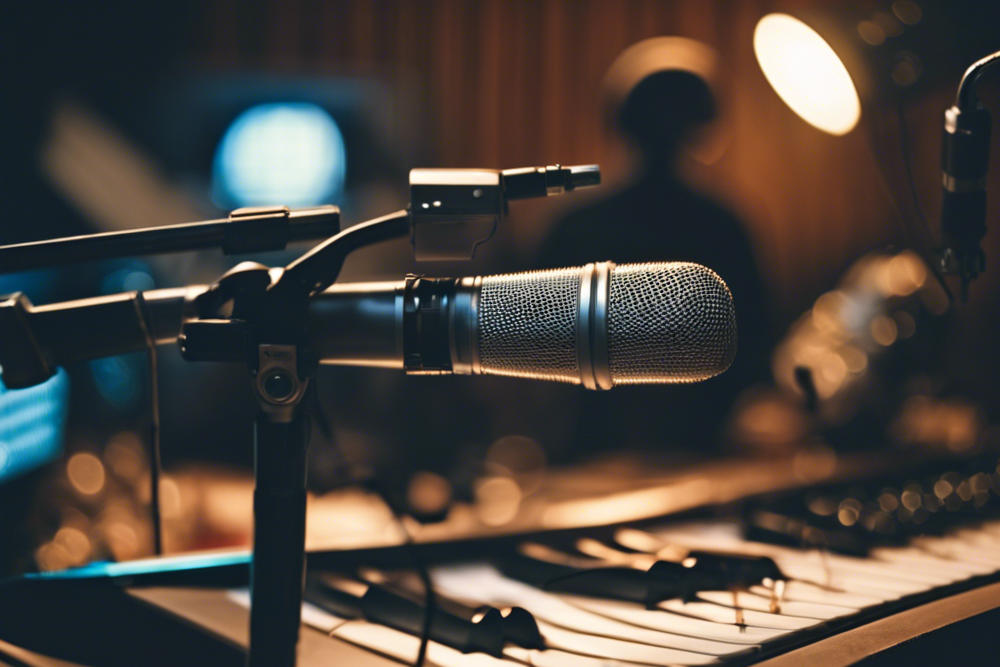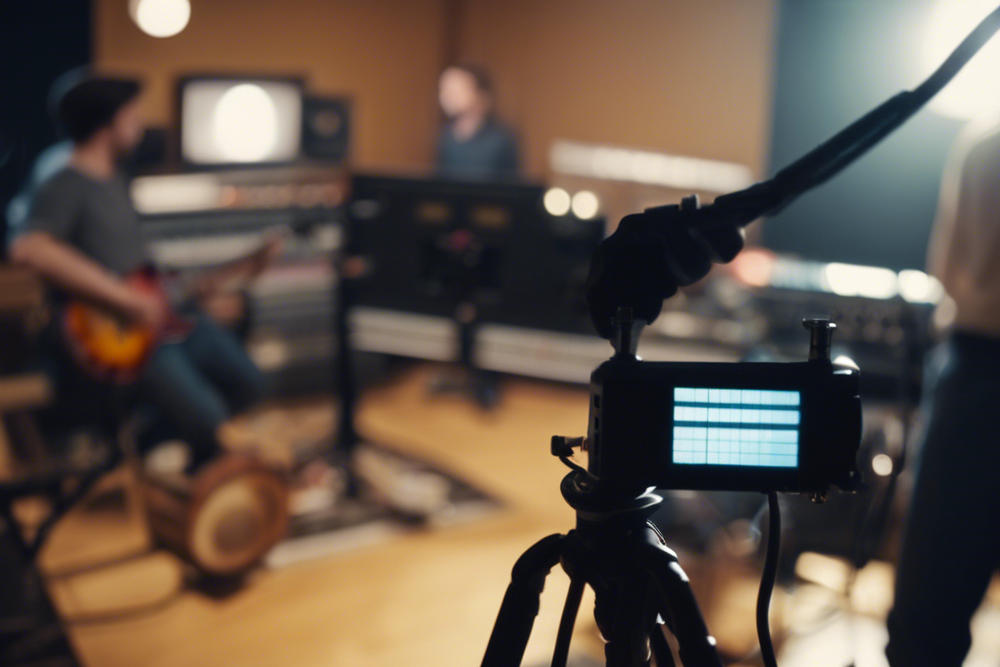Estimated reading time: 12 minutes
In the world of music albums, there’s a magical little piece often tucked between the beats and lyrics owning the spotlight—the interlude. It’s not just filler; it’s an art form, crafting a unique experience within the album’s journey. Let’s dive deeper and see how these musical breathers hold power to transform the narrative and flow of an album.
Table of contents
Defining an Interlude
What is an interlude?
An interlude in an album is a short piece of music or spoken word that serves as a bridge between two longer tracks. It often differs in tone and style from the surrounding tracks, providing a pause, a moment of reflection, or a shift in mood.
The purpose of an interlude
Interludes can serve various purposes in an album: they might offer a moment for the listener to digest the songs, or they provide a space where the artist can experiment or shift gears. Think of them as pallet cleansers that prepare you for the next flavor.
Historical Background
The origins of interludes in music
Interludes have their roots deeply embedded in classical and theatre music, where intermezzos and entr’actes provided structural breaks and time for scene changes.
The evolution of interludes in different genres
From jazz to hip-hop, each genre has molded its unique take on interludes. Hip-hop albums, for instance, sometimes use them for storytelling or thematic reinforcement, whereas in electronic music, they might build atmosphere.
| Aspect | Definition |
|---|---|
| Definition | An interlude in an album is a short piece of music or spoken word that serves as a bridge between two longer tracks. It often differs in tone and style from the surrounding tracks, providing a pause, a moment of reflection, or a shift in mood. |
| Purpose | Interludes can serve various purposes in an album: they might offer a moment for the listener to digest the songs, or they provide a space where the artist can experiment or shift gears. Think of them as pallet cleansers that prepare you for the next flavor. |
| Characteristics | – Short duration<br>- Different tone/style from surrounding tracks<br>- Can be musical or spoken word<br>- Serves as a bridge between tracks<br>- Offers pause, reflection, or mood shift |
| Historical Background | Interludes have roots in classical and theatre music, where intermezzos and entr’actes provided structural breaks and time for scene changes. |
| Evolution in Genres | Different genres have their unique takes on interludes: from storytelling in hip-hop to building atmosphere in electronic music. |
Types of Interludes
Instrumental interludes
These are purely musical and often feature a shift in instrumental focus. They can be subtly enchanting or boldly experimental, setting the stage without words.
Vocal interludes
Sometimes an interlude will focus on vocals, possibly layered or skewed, to offer a glimpse into a new dimension of the album’s narrative.

Transitional interludes
These are crafted specifically to enhance the flow—smoothly guiding the listener from one track to another, ensuring the album’s progression feels utterly natural.
| Type | Description |
|---|---|
| Instrumental Interludes | Purely musical segments often featuring a shift in instrumental focus. They can range from subtle and enchanting to bold and experimental, setting the stage without words. |
| Vocal Interludes | Focus on vocals, which may be layered or manipulated to offer a glimpse into a new dimension of the album’s narrative. These interludes can be emotive, atmospheric, or experimental in nature. |
| Transitional Interludes | Crafted specifically to enhance the flow of the album, smoothly guiding the listener from one track to another. They ensure the album’s progression feels natural and cohesive, without abrupt transitions. |
| Narrative Interludes | Introduce storytelling elements within the album, providing context or advancing the narrative arc. Common in concept albums or albums with a thematic storyline, they deepen the listener’s engagement with the music. |
| Experimental Interludes | Push the boundaries of traditional music structure, incorporating unconventional sounds, techniques, or formats. These interludes often serve as artistic expressions, challenging listeners’ expectations. |
Artists and Interludes
Notable artists known for incorporating interludes in their albums
Artists like Kendrick Lamar, with his thought-provoking narratives, or Beyoncé, known for her emotionally charged interludes, have masterfully used this tool to deepen the impact of their albums.
How interludes enhance an artist’s creative vision
Interludes allow artists to explore spaces outside their usual musical boundaries. These little pieces can be playgrounds for expressing finer emotions or bolder ideas.
| Artist | Notable Albums | Description |
|---|---|---|
| Kendrick Lamar | “To Pimp a Butterfly” | Known for thought-provoking narratives, Lamar masterfully integrates interludes to deepen the thematic elements of his albums. These interludes serve as bridges between tracks, offering insight into the album’s overarching concepts and social commentary. |
| Beyoncé | “Lemonade” | Renowned for emotionally charged interludes, Beyoncé’s albums feature powerful spoken-word segments and musical transitions that enhance the storytelling aspect of her work. These interludes often serve as emotional anchors, connecting the album’s tracks and providing context for the narrative unfolding within the music. |
| J. Cole | “2014 Forest Hills Drive” | J. Cole utilizes interludes to craft a cohesive narrative backbone within his albums. By incorporating skits, spoken-word segments, and transitional interludes, he creates an immersive listening experience that resonates with his audience. These interludes serve as pivotal moments in the album’s storytelling, allowing listeners to delve deeper into the themes and messages conveyed through his music. |
| Pink Floyd | “The Dark Side of the Moon” | Renowned for their innovative approach to album structure, Pink Floyd incorporates interludes as integral components of their conceptual works. These interludes serve as sonic bridges, seamlessly connecting the album’s tracks and contributing to its immersive atmosphere. By experimenting with soundscapes and unconventional musical elements, Pink Floyd elevates the role of interludes to enhance the thematic depth and emotional resonance of their albums. |
| Madonna | “Ray of Light” | Madonna incorporates interludes to great effect in her albums, using them as transitional elements that enhance the flow and cohesion of the music. These interludes serve as sonic palette cleansers, guiding listeners through the diverse sonic landscapes explored within the album. By experimenting with different musical styles and textures, Madonna creates a dynamic listening experience that captivates audiences and showcases her versatility as an artist. |
Production and Role of Interludes
Role of interludes in album production
In the grand design of an album, interludes act like architectural columns—both supportive and ornamental, bringing the whole structure together.
How interludes contribute to the overall listening experience
They enrich the listening journey, making albums not just a collection of singles but a cohesive story, where each part, including the quiet ones, plays a pivotal role.
| Aspect | Description |
|---|---|
| Role in Album Production | Interludes act as architectural elements within the album’s structure, providing support and cohesion to the overall composition. They serve as bridges between tracks, enhancing the flow and narrative coherence of the album. Additionally, interludes contribute to the album’s thematic depth and emotional resonance, enriching the listening experience for the audience. |
| Contribution to Listening Experience | Interludes enrich the listening journey by offering moments of pause, reflection, or transition within the album. They provide sonic and thematic variation, preventing listener fatigue and maintaining engagement throughout the album. By carefully crafting interludes, artists and producers enhance the overall listening experience, transforming albums into immersive sonic narratives. |
| Artistic Expression | Interludes serve as platforms for artistic experimentation, allowing artists and producers to explore unconventional sounds, textures, and techniques. They provide opportunities for sonic innovation and creative expression, enabling artists to push the boundaries of traditional music production and engage listeners on a deeper emotional and intellectual level. |
| Narrative Framing | Interludes play a crucial role in framing the album’s narrative arc, providing context, tension, and resolution within the music. They introduce thematic motifs, develop character arcs, and advance storytelling elements, creating a cohesive and compelling listening experience for the audience. Through strategic placement and composition, interludes contribute to the album’s overarching narrative structure and thematic coherence. |
| Collaborative Process | The production of interludes often involves collaboration between artists, producers, and sound designers. It requires careful planning, experimentation, and iteration to achieve the desired sonic and emotional impact. Through collaborative effort, interludes are crafted to complement the album’s themes, enhance its sonic palette, and contribute to its overall artistic vision. |
Impact and Significance
The impact of interludes on creating connective tissue within an album
Just like connective tissue in our bodies supports and frames our organs, interludes support and frame the main tracks, giving albums a robust structure and flow.

Interludes as moments of reflection or transition
Interludes often act as breathers, moments where listeners can pause and reflect or brace for a transition, enhancing the emotional and intellectual engagement with the album.
| Aspect | Description |
|---|---|
| Structural Support | Interludes serve as the connective tissue within an album, providing structural support and cohesion to the overall composition. They frame the main tracks, guide the listener through the album’s narrative arc, and ensure a seamless flow from one song to the next. |
| Narrative Enhancement | Like chapters in a book, interludes deepen the album’s narrative by introducing thematic motifs, character development, and storytelling elements. They offer moments of reflection, transition, or tension, enriching the listener’s emotional and intellectual engagement with the music. |
| Emotional Resonance | Interludes evoke powerful emotions and moods, enhancing the album’s emotional resonance and impact on the listener. Whether through evocative music or poignant spoken-word segments, interludes create immersive sonic landscapes that elicit a range of feelings and experiences. |
| Artistic Expression | Interludes provide artists with a platform for artistic experimentation and expression. They allow musicians to explore diverse musical styles, textures, and concepts, pushing the boundaries of traditional music production and showcasing their creativity and innovation. |
| Listener Experience Enrichment | Interludes transform albums into immersive sonic journeys, offering listeners a multi-dimensional experience beyond individual tracks. They captivate audiences, sustain interest throughout the album, and leave a lasting impression by creating a cohesive and memorable listening experience. |
Analyzing Examples
Exploring interludes in popular albums
Madonna’s Ray of Light or Pink Floyd’s The Dark Side of the Moon use interludes to great effect, each in their way carving deeper into the listener’s experience.
Examining the effectiveness of interludes in enhancing the album’s narrative
In J. Cole’s 2014 Forest Hills Drive, interludes craft a narrative backbone that makes the album’s story palpable and more relatable.
| Album | Artist | Description |
|---|---|---|
| “Ray of Light” | Madonna | Madonna’s “Ray of Light” incorporates interludes to great effect, enhancing the album’s flow and cohesion. For instance, the interlude between “Swim” and “Ray of Light” features atmospheric sounds and spoken-word samples, creating a seamless transition between the two tracks. These interludes serve as sonic palette cleansers, guiding listeners through the diverse sonic landscapes explored within the album. |
| “The Dark Side of the Moon” | Pink Floyd | Pink Floyd’s “The Dark Side of the Moon” is renowned for its innovative use of interludes as integral components of the album’s conceptual framework. For example, the heartbeat sound effect recurring throughout the album serves as a sonic motif, linking the tracks and contributing to the album’s immersive atmosphere. These interludes elevate the album’s thematic depth and emotional resonance. |
| “Lemonade” | Beyoncé | Beyoncé’s “Lemonade” utilizes interludes to enhance the album’s storytelling aspect and emotional impact. The spoken-word segments and musical transitions between tracks provide context for the narrative unfolding within the album. For instance, the interlude “Hope” features a powerful spoken-word poem, adding depth and intensity to the album’s themes of empowerment and resilience. |
| “2014 Forest Hills Drive” | J. Cole | J. Cole’s “2014 Forest Hills Drive” employs interludes to craft a cohesive narrative backbone within the album. For example, the skits and spoken-word segments interspersed throughout the album serve as pivotal moments in the storytelling, allowing listeners to delve deeper into the themes and messages conveyed through the music. These interludes enhance the album’s emotional resonance and relatability. |
| “To Pimp a Butterfly” | Kendrick Lamar | Kendrick Lamar’s “To Pimp a Butterfly” integrates interludes to deepen the thematic elements of the album. The spoken-word segments and musical interludes serve as bridges between tracks, offering insight into the album’s overarching concepts and social commentary. For instance, the interlude “For Free?” features a provocative spoken-word performance, challenging societal norms and expectations. |
Modern Trends and Future Possibilities
Current trends in interludes across various genres
As music evolves, so do interludes. Today, they are more than just gap fillers; they are integral, creative pieces crucial to an album’s identity in genres as diverse as indie, electronic, and mainstream pop.
The potential of interludes in shaping the future of music production
With evolving technology and shifting listener habits, the creative possibilities for interludes are boundless. They are poised to become more experiential and immersive in future music productions.
| Trend/Possibility | Description |
|---|---|
| Diverse Genres Incorporating Interludes | Interludes are becoming more prevalent across diverse music genres, including indie, electronic, and mainstream pop. Artists are experimenting with interludes to enhance album narratives, create atmospheric transitions, and showcase their creative versatility. |
| Interactive and Immersive Experiences | With advancements in technology, future interludes may offer interactive and immersive experiences for listeners. Virtual reality (VR) and augmented reality (AR) technologies could be utilized to create immersive sonic landscapes, allowing listeners to explore music in innovative and engaging ways beyond traditional audio formats. |
| Collaborative Production and Cross-Media Integration | Interludes could involve collaborative production processes, with artists collaborating with filmmakers, visual artists, and storytellers to create multi-dimensional experiences. Cross-media integration could see interludes extending beyond audio recordings to include visual components, such as music videos, short films, or multimedia installations, enhancing the narrative and artistic impact of albums. |
| AI-Driven Interludes | Artificial intelligence (AI) technologies may play a role in the creation of interludes, offering new possibilities for automated composition, sound design, and personalized music experiences. AI algorithms could analyze listener preferences and album contexts to generate interludes tailored to individual tastes and album themes, providing unique and adaptive listening experiences. |
| Interactive Fan Engagement | Future interludes could facilitate interactive fan engagement, allowing listeners to contribute to the creation or remixing of interlude segments. Social media platforms and online communities could provide platforms for fans to share their interpretations, remixes, and responses to interludes, fostering a sense of community and collaboration among artists and listeners. |
Conclusion
Far from being just space-fillers, interludes are a powerful artistic tool in an album’s arsenal. They are bridges, breaths, and bold statements wrapped into one, telling stories that words or melodies alone could not.
Related Posts
- What Makes a Good Song? Unlocking the Mysteries of Memorable Music
- Choir vs Chorus: The Simple Guide to the Difference Between Choir and Chorus
- What is Quantization in Music? Unraveling the Mystery
- What is a MIDI File? Unraveling the Mystery
- How to use an Audio Interface? A Beginner’s Guide
- What is FX in Audio Mixer: Understanding Effects in Sound Production
FAQs
Not all, but many artists choose to use interludes to enhance the story or flow of their albums.
You could, but you might miss out on the full emotional and narrative experience the artist intended.
They vary widely but typically last anywhere from 30 seconds to two minutes.
No, interludes can be part of plays, movies, or live shows – anywhere a transitional or reflective moment is beneficial.
Artists and producers might use a variety of methods, from recording improvisational sessions to carefully crafting sonic pieces relevant to the album’s theme.
